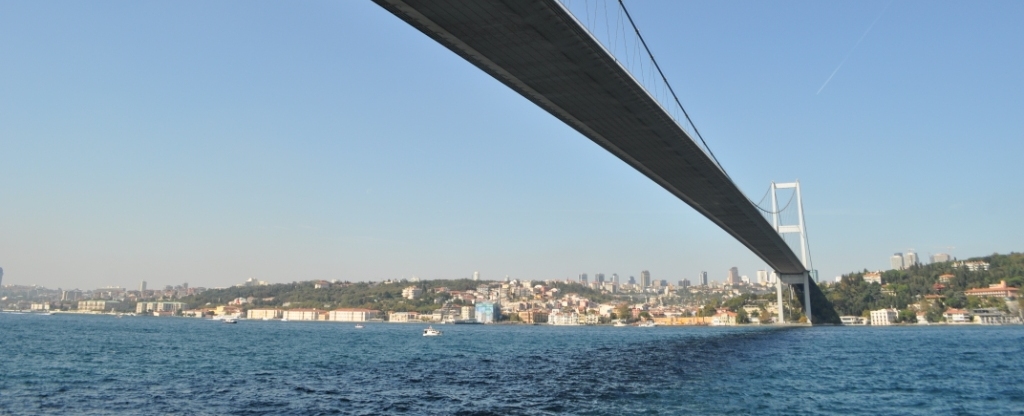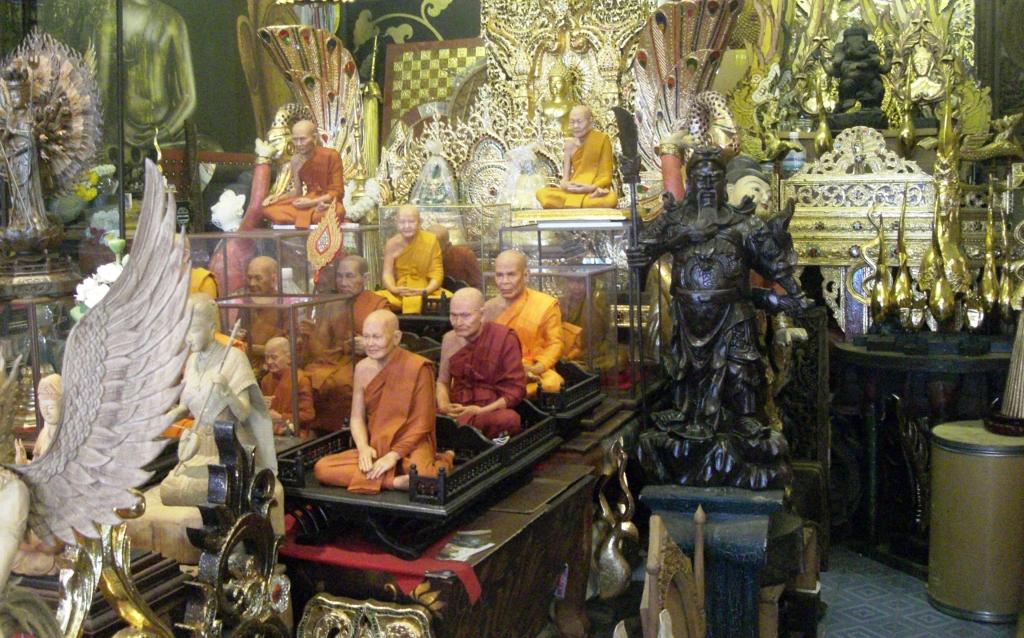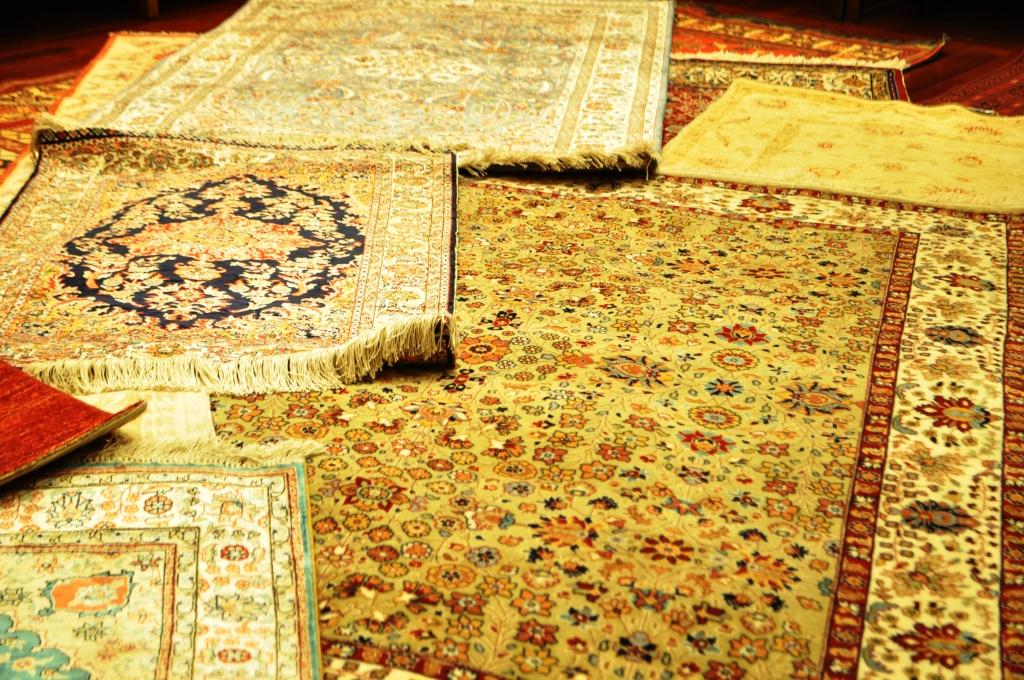Talk about Continental Drift: I am floating — literally — between Asia and Europe. To my left is familiarity, reassuring names like Paris and Venice, Vienna and Madrid. To my right are places like Kazakhstan and Urumqi: the exotic lands of western Asia, with their unpronounceable names and incomprehensible customs. Do Asians look west and wonder about the many mysteries of McDonald’s and Starbucks, the strange garb of European businessmen, the secrets of what lies inside a western woman’s handbag? Perhaps not any more. But a deep submarine chasm runs beneath the Bosphorus: The divide is still there, and I am floating on it, in a boat.
In Your Bucket Because….
- How many times in your life will you get to float between two continents?
- The scenery gives you a good view of the enormity of modern Istanbul, along with with its historical structures.
- Good for: Anyone who doesn’t get seasick.
Bumper Cars on the Bosphorus
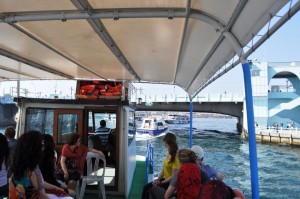
It started with what seemed like a game of bumper cars. I boarded the good ship Denis Ruÿas near the Galata Bridge, which spans the Golden Horn, a finger of water that briefly cuts into the European side of Istanbul. The bridge is low enough to prevent large ships from wandering in to the Golden Horn, but it’s also a bottleneck, and there are a score of day-cruise ships vying to get through in either direction. We came within a few feet of bashing into a fishing boat whose sole occupant was nowhere near the steering wheel, but was instead casting off the rear of the boat.
Entering the Marmara Sea, we found ourselves in one of the busiest shipping lanes in the world: the Turkish Straits. The Marmara Sea lies against Istanbul between the Dardanelles, which lead south to the Aegean, and the Bosphorus, which leads north to the Black Sea. A humongous Chinese freighter accompanied us toward the Bosphorus Strait, most probably having come through the Suez Canal to the Mediterranean, then up the Aegean through the Dardanelles into the Marmara. Its likely itinerary teases my brain with thoughts of Egyptian Pyramids and Greek Islands, of ancient Troy and modern Gallipoli, storied places: Homer’s Odyssey, St. John’s Revelations.
And now that Chinese superfreighter is carrying who-knows what to the Black Sea, perhaps to Russian ports. The right-of-way rules of the sea have always been something of a mystery to me, but here they seem to follow the same rules of the road as drivers on Turkish streets: there aren’t any except, maybe, don’t get hit. The Bosphorus Strait, where we are headed, is not only busy, but also dangerous, with heavy traffic, strong currents, and turns that challenge even the most skilled captains of the big ships. The pilots of the fishing boats don’t seem perturbed. Indeed, they aren’t even looking.
The World in a Boat
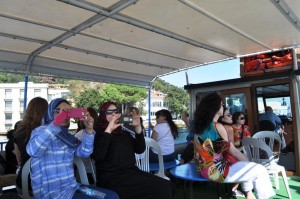
I glance around at my companions, who seem to be tourists who hail from everywhere. There’s a woman with hair dyed the bright red of the Turkish flag, and a large Middle-Eastern family — one father in western clothing, wife and daughters each wearing a headscarf and taking pictures with cell phones. There’s a group of Scandinavians who head straight for the sunniest spot on the boat. I hear Aussie and English accents, and German and Dutch, and a couple of Americans, and a lot of languages I can’t identify.
But we’re all here for the same reason. Of all the boat tours in all the cities of the world, this is the only one that separates continents. The Bosphorus is only 20 miles long — you could walk to the Black Sea from Istanbul if you were sufficiently hardy — but taking a boat ride is one of Istanbul’s must-do tourist activities, making for a relaxing break from monuments, mosques, and museums, not to mention shopping bazaars.
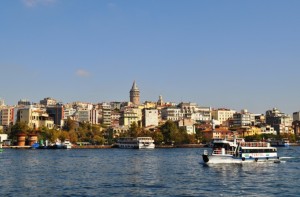
The scenery is quite literally epic: We leave behind us the Sultanahmet, which contains the Topkapi palace, inspiration, it is said, for Mozart’s Abduction from the Seraglio. Behind us, the Blue Mosque and Hagia Sofia get smaller as we draw away from the hilly peninsula that holds most of Istanbul’s major museums and tourist sites. We drift past the the Galata tower, built in 1348. At about 200 feet, it was the tallest building in Istanbul when it was built. So it was an obvious choice to launch the world’s first intercontinental airplane trip — in about 1630, when a scientist named Hezarfen Ahmet Çelebi reportedly used artificial wings to fly six kilometers — over the Bosphorus and clear to Asia. Today the tower houses a cafe, nightclub, and a trendy restaurant with a 360 degree view.
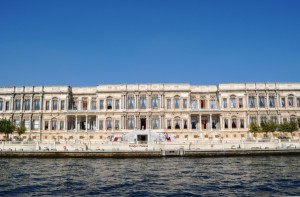
Turning the corner past the Bosporus Bridge, we pass the Çırağan Palace, once an Ottoman Palace, now a Lempinski hotel, which barely fits into my camera even when the lens is opened to its widest; the Intercontinental Hotel sits, palatial, on the water’s edge; then there is a series of minarets and mosques and palaces, and finally we arrive at the 3,524-foot long Bosphorus bridge, once the longest in the world. At about the midpoint of our trip, a steward comes by selling tea.
On the strait, traffic is somewhat lighter, although we’re still accompanied by the Chinese freighter and more one-man fishing boats, all of them unsteered because their pilots are also their fishermen. Going crosswise are the working ferries that bounce from Asia to Europe and back again several times a day.
The bridge is long and graceful, arching overhead, and like the grand palaces, it doesn’t fit in my camera — nor in my mind. A million people a day travel between the European and Asian side, most of them just doing their ordinary daily errands and commutes, crossing between continents, between worlds, or maybe just between home and work. I look up to see the traffic stalled on the bridge, just like at home on the George Washington Bridge into New York City.
After going a bit farther, the cruise boat turns around and crosses back under the bridge. Above me, traffic is still at a standstill. I imagine the drivers looking at their watches, talking on their cell phones, craning their necks to see what the delay is. Back at home on the GW Bridge, I don’t give a thought to crossing the Hudson River: I pay the toll, bully my way into the correct lane, snarl at the traffic. But here, I wonder: Is anyone on that entire bridge at the moment musing at the wonder of being stuck between two continents? Or is it just another commute, another ordinary day?
Practicalities
There are several ways to take a Bosphorus cruise:
- Dozens of tourist cruise boats line up on the south side of the Golden Horn near the Galata Bridge (about a 15 minute walk from the Topaki Palce in the Sultanahmet). You won’t have to worry about finding a boat: once you reach the dock area near Eminönü, a shill will find you. Note that the commercial tours offered by the touts will cost about $20 Euros and last for between an hour and a half to two hours: They take you to the Bosphorus Bridge and back, or to the Fatih Sultan Mehmet Bridge, a bit further up the strait, and back.
- For a longer cruise, you can take a full-day tour all the way to the Black Sea. It’s a full-day tour: about 2 hours on the boat, a three hour lunch stop, and a two hour return.
- You can take the public ferries that run across the Bosphorus from the European to the Asian side, spend some time exploring the Asian side, then come back when you are ready (10 to 20 TL).
- Dinner, evening, and moonlight cruises are also available. Make arrangements in advance, based on recommendations from other travelers, a trustworthy hotel, or a guidebook, so you don’t get waylaid by the touts.
- It makes sense to combine a morning cruise with an afternoon spice market stop (or vice versa) as the two are close to each other.
- Or you could walk across the Galata bridge — in itself worth exploring, as its a bit of a semi-floating bazaar — and on to the Galata tower.
